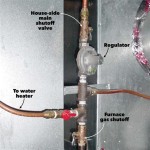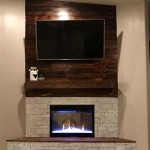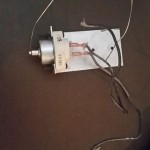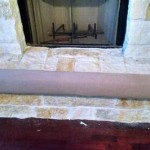Slate Around Fireplace: A Durable and Elegant Choice
Slate, a metamorphic rock formed from shale or mudstone under immense pressure and heat, has long been valued for its durability, versatility, and aesthetic appeal. Its inherent properties make it an excellent material for various construction and design applications, including the areas surrounding fireplaces. Employing slate around a fireplace not only enhances the visual appeal of the hearth but also provides practical benefits related to heat resistance, ease of maintenance, and longevity.
The use of slate around a fireplace encompasses several applications. It can be used as a hearth, the non-combustible surface extending outward from the fireplace opening. Slate can also be incorporated as a surround, framing the fireplace opening and providing a decorative element. Furthermore, slate can be used as a facing, covering the wall area directly above and around the fireplace. Each application offers unique design possibilities and contributes to the overall aesthetic and functional qualities of the fireplace area.
Durability and Heat Resistance
Slate's inherent durability is one of its most significant advantages for fireplace applications. Formed under extreme pressure, slate possesses a dense, compact structure that resists cracking, chipping, and abrasion. This resilience is particularly crucial in areas surrounding a fireplace, where the material is subjected to fluctuating temperatures and potential impacts from logs or fireplace tools. Slate's ability to withstand these conditions ensures its longevity and minimizes the need for frequent repairs or replacements.
Furthermore, slate exhibits excellent heat resistance. While not entirely impervious to heat, slate can withstand significant temperature variations without warping, cracking, or undergoing significant structural changes. This heat resistance is essential for hearths and surrounds, where direct contact with flames or hot embers is possible. The ability to tolerate high temperatures makes slate a safer and more reliable material choice compared to other options that may be prone to damage or degradation under heat.
The thermal properties of slate also contribute to its efficiency. Slate is a relatively good conductor of heat, meaning it can absorb and radiate heat effectively. This is particularly beneficial for fireplaces that are used as a supplementary heating source. The slate surround can absorb heat from the fire and gradually release it into the surrounding room, contributing to a more consistent and comfortable temperature. However, the extent of heat radiation depends on factors such as the thickness and surface area of the slate, as well as the overall design of the fireplace.
Aesthetic Versatility and Design Options
Beyond its practical benefits, slate offers significant aesthetic versatility. Its natural texture and color variations provide a unique and sophisticated look that can complement a wide range of interior design styles. Slate is typically available in various shades of gray, black, green, and purple, often with subtle variations in tone and veining that add character and depth to the material. These natural variations make each slate installation unique and contribute to the overall visual appeal of the fireplace area.
The variety of finishes available for slate also enhances its design versatility. Slate can be honed, which creates a smooth, matte surface with a subtle sheen. Honing enhances the natural color variations of the slate and provides a sophisticated and understated look. Alternatively, slate can be cleft, which retains its naturally textured surface. Cleft slate has a more rustic and tactile appearance, adding a sense of warmth and character to the fireplace area. Polished slate, while less common in fireplace applications due to its potential for glare, provides a high-gloss finish that emphasizes the color and veining of the stone.
Slate can be incorporated into various fireplace designs, from traditional to contemporary. In traditional settings, slate can be paired with classic architectural elements, such as ornate mantels and decorative tiles. In contemporary designs, slate can be used to create a sleek and minimalist look, often combined with clean lines and geometric shapes. The neutral color palette of slate makes it a versatile choice that can be easily integrated into a variety of design schemes. The size and shape of the slate tiles or slabs can also be customized to fit the specific dimensions and design requirements of the fireplace.
Installation and Maintenance Considerations
Proper installation is crucial for ensuring the longevity and performance of slate around a fireplace. The installation process typically involves preparing the substrate, applying a suitable adhesive, and carefully positioning the slate tiles or slabs. It is essential to use a high-quality adhesive that is specifically designed for use with natural stone and can withstand the temperature variations associated with fireplaces. The substrate, which is the surface beneath the slate, must be clean, level, and structurally sound to ensure proper adhesion and prevent cracking or shifting of the slate.
Grouting is another important aspect of slate installation. Grout fills the gaps between the slate tiles or slabs, providing a seamless and water-resistant surface. It is essential to use a grout that is specifically designed for use with natural stone, as some grouts can stain or damage the slate. The grout color should be carefully selected to complement the color of the slate and enhance the overall aesthetic of the fireplace area. After the grout has been applied, it should be properly sealed to prevent staining and water damage.
Maintaining slate around a fireplace is relatively straightforward. Regular cleaning with a mild detergent and water is typically sufficient to remove dust, dirt, and soot. Avoid using harsh chemicals or abrasive cleaners, as these can damage the slate's surface. Periodic sealing of the slate can help to protect it from staining and water damage. The frequency of sealing depends on the type of slate and the level of exposure to moisture and spills. Inspecting the slate regularly for cracks or chips is also important. Minor damage can often be repaired using epoxy or other patching compounds. Promptly addressing any issues can prevent further damage and extend the lifespan of the slate installation.
In conclusion, slate offers a compelling combination of durability, aesthetic versatility, and relatively easy maintenance, making it a popular and practical choice for incorporating around a fireplace. Its ability to withstand heat and resist damage, coupled with its natural beauty and design flexibility, makes it a valuable asset for enhancing the visual appeal and functionality of the hearth area. Careful consideration of installation and maintenance practices will ensure the longevity and continued beauty of the slate surround, hearth, or facing for years to come.

8 Best Slate Fireplace Ideas Surrounds

Northern Slate Fireplace Surround Project Genstone

Slate Fireplace Surround Photos Ideas Houzz

Today Is The Perfect Day To Share Our Finished Fireplace What Do You Think See Whole Transform Tile Outdoor Designs Design

Sprucing Up The Fireplace

Fireplace Surrounds Soapstone Slate Wood And Marble Countertop Projects Garden State

Sprucing Up The Fireplace

Slate Hearths Fireplace Surrounds Lbs

How To Clean Slate Fireplace The Blog At Fireplacemall

Contemporary Slate Fireplace Tile Surround Remodel
Related Posts








